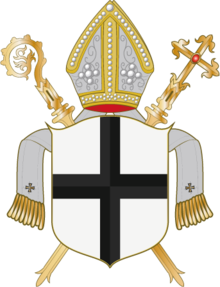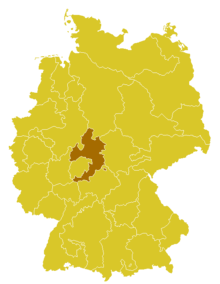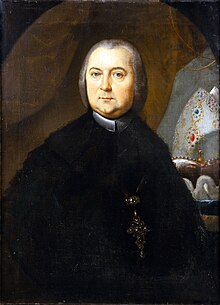Roman Catholic Diocese of Fulda: Difference between revisions
Neddyseagoon (talk | contribs) |
m →top: Typo fixing, replaced: of th → of the |
||
| (22 intermediate revisions by 20 users not shown) | |||
| Line 1: | Line 1: | ||
{{Short description|Catholic diocese in Germany}} |
|||
{{Unreferenced|date=May 2016}} |
|||
{{Redirect|Bishopric of Fulda|the former Prince-Bishopric and state of the Holy Roman Empire|Fulda monastery}} |
|||
{{More citations needed|date=January 2021}} |
|||
{{Infobox diocese |
{{Infobox diocese |
||
|jurisdiction = Diocese |
|jurisdiction = Diocese |
||
| Line 8: | Line 10: | ||
|caption = [[Fulda Cathedral]] |
|caption = [[Fulda Cathedral]] |
||
|coat = Wappen Bistum Fulda.png |
|coat = Wappen Bistum Fulda.png |
||
|country = |
|country = {{flag|Germany}} |
||
|province = Paderborn |
|province = Paderborn |
||
|metropolitan = [[Roman Catholic Archdiocese of Paderborn|Paderborn]] |
|metropolitan = [[Roman Catholic Archdiocese of Paderborn|Paderborn]] |
||
| Line 15: | Line 17: | ||
|denomination = [[Roman Catholic]] |
|denomination = [[Roman Catholic]] |
||
|established = 5 October 1752 |
|established = 5 October 1752 |
||
|rite = [[Latin Rite]] |
|rite = [[Latin Church|Latin Rite]] |
||
|area_km2 = 10,318 |
|area_km2 = 10,318 |
||
|population = 1, |
|population = 1,720,203 |
||
|population_as_of = 31 December |
|population_as_of = 31 December 2017<ref>[https://www.bistum-fulda.de/bistum_fulda/bistum/zahlen_fakten/zahlen.php Diocese 2017]</ref> |
||
|catholics = |
|catholics = 392,840 |
||
|catholics_percent= |
|catholics_percent= 22.8 |
||
|cathedral = [[Fulda Cathedral]] |
|cathedral = [[Fulda Cathedral]] |
||
|patron = [[Saint Boniface]] <small> main patron </small><br /> [[Elisabeth of Hungary|Saint Elisabeth]] <small> second patron </small> |
|patron = [[Saint Boniface]] <small> main patron </small><br /> [[Elisabeth of Hungary|Saint Elisabeth]] <small> second patron </small> |
||
|parishes = |
|parishes = 274 |
||
|priests = |
|priests = 262 |
||
|pope = {{Incumbent pope}} |
|pope = {{Incumbent pope}} |
||
|bishop = [[ |
|bishop = [[Michael Gerber (bishop)|Michael Gerber]] |
||
|auxiliary_bishops= Karlheinz Diez |
|auxiliary_bishops= Karlheinz Diez |
||
|vicar_general = |
|vicar_general = Christof Steinert |
||
|emeritus_bishops |
|emeritus_bishops = [[Heinz Josef Algermissen]] |
||
|map = Karte Bistum Fulda.png |
|map = Karte Bistum Fulda.png |
||
|map_caption = Current extent of the Diocese |
|map_caption = Current extent of the Diocese |
||
|website = [http://www.bistum-fulda.de bistum-fulda.de] |
|website = [http://www.bistum-fulda.de bistum-fulda.de] |
||
}} |
}} |
||
The '''Diocese of Fulda''' ( |
The '''Diocese of Fulda''' ({{lang-la|Dioecesis Fuldensis}}) is a [[Latin Church]] [[diocese]] of the [[Catholic Church]] in the north of the [[Germany|German]] state of [[Hessen]]. It is a [[suffragan diocese]] of the [[Roman Catholic Archdiocese of Paderborn|Archdiocese of Paderborn]]. The [[bishop]]'s [[episcopal see|seat]] is in [[Fulda Cathedral]]. |
||
==History== |
==History== |
||
| Line 45: | Line 47: | ||
In 1220, the abbey was elevated to an [[abbey-principality]] by [[Frederick II, Holy Roman Emperor|Frederick II]]. In 1571, Jesuits settled in Fulda and made a considerable contribution to the efforts of the [[Counter-Reformation]]. |
In 1220, the abbey was elevated to an [[abbey-principality]] by [[Frederick II, Holy Roman Emperor|Frederick II]]. In 1571, Jesuits settled in Fulda and made a considerable contribution to the efforts of the [[Counter-Reformation]]. |
||
During the reign of Prince-abbot Balthasar von Dernbach (1570-1576 and 1602-1606), the region was the site of extensive [[witch-hunt]]s with 300 witch-trials carried out in three years. This number made Fulda one of the central areas of the early-modern European witch-hunts. |
During the reign of Prince-abbot [[Balthasar von Dernbach]] (1570-1576 and 1602-1606), the region was the site of extensive [[witch-hunt]]s with 300 witch-trials carried out in three years. This number made Fulda one of the central areas of the early-modern European witch-hunts. |
||
On 5 October 1752, [[Pope Benedict XIV]] raised the abbey to the level of a diocese. |
On 5 October 1752, [[Pope Benedict XIV]] raised the abbey to the level of a diocese. |
||
| Line 51: | Line 53: | ||
In 1802, with the [[German mediatisation]], the political principality of the diocese was dissolved, but the diocese itself remained. Prince-Bishop Adalbert von Harstall remained the bishop of the diocese until his death in 1814. After his death the diocese was overseen by an administrator rather than a bishop. The borders of the diocese were altered by [[papal bull]]s in 1821 and 1827. In 1857, the diocese was expanded to include the [[grand duchy]] of [[Saxe-Weimar]]. From 1873 to 1881, during the [[Kulturkampf]], when Chancellor [[Otto von Bismarck]] attempted to lessen the political power of the church, the bishop's seat sat empty again. |
In 1802, with the [[German mediatisation]], the political principality of the diocese was dissolved, but the diocese itself remained. Prince-Bishop Adalbert von Harstall remained the bishop of the diocese until his death in 1814. After his death the diocese was overseen by an administrator rather than a bishop. The borders of the diocese were altered by [[papal bull]]s in 1821 and 1827. In 1857, the diocese was expanded to include the [[grand duchy]] of [[Saxe-Weimar]]. From 1873 to 1881, during the [[Kulturkampf]], when Chancellor [[Otto von Bismarck]] attempted to lessen the political power of the church, the bishop's seat sat empty again. |
||
In 1929, the diocese lost some regions in the area of [[Frankfurt am Main]] to the [[diocese of Limburg]], receiving the predominant Catholic commissariat in [[Heilbad Heiligenstadt|Heiligenstadt]] and the [[deanery]] of [[Erfurt]] from the [[diocese of Paderborn]], itself elevated to |
In 1929, the diocese lost some regions in the area of [[Frankfurt am Main]] to the [[diocese of Limburg]], receiving the predominant Catholic commissariat in [[Heilbad Heiligenstadt|Heiligenstadt]] and the [[deanery]] of [[Erfurt]] from the [[diocese of Paderborn]], itself elevated to archdiocese. The Diocese of Fulda then switched as [[suffragan]] from the [[Upper Rhenish Ecclesiastical Province]] to the new Paderbon-led [[Middle German Ecclesiastical Province]]. |
||
During the partition of Germany after [[World War II]], it became much more difficult for the Bishop of Fulda, as well as the [[Diocese of Würzburg|Bishop of Würzburg]], to conduct the business of his office in the parts of his diocese which lay in the eastern zone. Therefore, 1946 saw the appointment of the provost of the [[Erfurt Cathedral]] to the position of [[vicar general]] of the eastern sections of both the Fuldean and Würzburger diocese. In 1953, he was made [[auxiliary bishop]] of the region. With the reordering of the Catholic Church in [[East Germany]], in 1973, by decree of the [[Holy See]], the East German regions of both diocese were reassigned to the Episcopal Office of Erfurt-Meiningen ({{lang-de|Bischöfliche Amt Erfurt-Meiningen}}). The leader of the Episcopal Office was an [[apostolic administrator]] and [[titular bishop]]. |
During the partition of Germany after [[World War II]], it became much more difficult for the Bishop of Fulda, as well as the [[Diocese of Würzburg|Bishop of Würzburg]], to conduct the business of his office in the parts of his diocese which lay in the eastern zone. Therefore, 1946 saw the appointment of the provost of the [[Erfurt Cathedral]] to the position of [[vicar general]] of the eastern sections of both the Fuldean and Würzburger diocese. In 1953, he was made [[auxiliary bishop]] of the region. With the reordering of the Catholic Church in [[East Germany]], in 1973, by decree of the [[Holy See]], the East German regions of both diocese were reassigned to the Episcopal Office of Erfurt-Meiningen ({{lang-de|Bischöfliche Amt Erfurt-Meiningen}}). The leader of the Episcopal Office was an [[apostolic administrator]] and [[titular bishop]]. |
||
| Line 62: | Line 64: | ||
*Saint Boniface (main patron) |
*Saint Boniface (main patron) |
||
*Saint [[Elisabeth of Hungary]] (secondary patron) |
*Saint [[Elisabeth of Hungary]] (secondary patron) |
||
*Saint [[Bardo]] |
*Saint [[Bardo (bishop)|Bardo]] |
||
*Saint [[Leoba]] |
*Saint [[Leoba]] |
||
*Saint [[Rabanus Maurus]] |
*Saint [[Rabanus Maurus]] |
||
| Line 68: | Line 70: | ||
==Ordinaries== |
==Ordinaries== |
||
[[Image:Image-HeinrichvonBibraHerrlein.jpg|right|thumb |
[[Image:Image-HeinrichvonBibraHerrlein.jpg|right|thumb|Prince-Bishop, Prince-Abbot |
||
Heinrich von Bibra by his court painter, Johann Andreas Herrlein]] |
Heinrich von Bibra by his court painter, Johann Andreas Herrlein]] |
||
For a list of medieval abbots see [[Fulda monastery|Rulers of Fulda until Secularization]] |
For a list of medieval abbots see [[Fulda monastery|Rulers of Fulda until Secularization]] |
||
#Amand von Buseck, O.S.B. (1738–1756) |
|||
#Adalbert von Walderdorf, O.S.B. (1757–1759) |
|||
#[[Heinrich von Bibra]], O.S.B. (1759–1788) |
|||
#Adalbert Freiherr (Wilhelm Adolph Heinrich) von Harstall, O.S.B. (1788–1814) |
|||
*Heinrich Freiherr (Philipp Ernst) von Warnsdorf, O.S.B. ( |
#*Heinrich Freiherr (Philipp Ernst) von Warnsdorf, O.S.B. (1814–1817), [[vicar apostolic]] |
||
#[[Johann Adam Rieger]] (1828–1831) |
|||
#[[Johann Leonhard Pfaff]] (1831–1848) |
|||
#[[Christoph Florentius Kött]] (1848–1873) |
|||
#[[Georg von Kopp]] (1881–1887) |
|||
#[[Joseph Weyland (bishop)|Joseph Weyland]] (1887–1894) |
|||
#[[Georg Ignatz Komp]] (1894–1898) |
|||
#Adalbert Endert (1898–1906) |
|||
#Joseph Damian Schmitt (1906–1939) |
|||
#Johann Baptist Dietz (1939–1958) |
|||
#Adolf Bolte (1959–1974) |
|||
#[[Eduard Schick]] (1974–1982) |
|||
#Johannes Dyba (1983–2000) |
|||
#[[Heinz Josef Algermissen]] (2001–2018) |
|||
#Michael Gerber (from 2019) |
|||
==References== |
==References== |
||
| Line 98: | Line 101: | ||
*[http://www.newadvent.org/cathen/06313b.htm Diocese of Fulda on Catholic Encyclopedia] |
*[http://www.newadvent.org/cathen/06313b.htm Diocese of Fulda on Catholic Encyclopedia] |
||
{{Hierarchy of the Catholic Church in Germany}} |
|||
{{Dioceses in Germany|state=collapsed}} |
{{Dioceses in Germany|state=collapsed}} |
||
{{coord|50|33|15|N|9|40|18.3|E|source:plwiki|display=title}} |
{{coord|50|33|15|N|9|40|18.3|E|source:plwiki|display=title}} |
||
| Line 109: | Line 113: | ||
[[Category:Christianity in Bavaria|Fulda]] |
[[Category:Christianity in Bavaria|Fulda]] |
||
[[Category:Christianity in Thuringia|Fulda]] |
[[Category:Christianity in Thuringia|Fulda]] |
||
[[ |
[[Category:Roman Catholic bishops of Fulda|*]] |
||
[[Category:Fulda Cathedral]] |
|||
Latest revision as of 15:00, 28 February 2024
This article needs additional citations for verification. (January 2021) |
Diocese of Fulda Dioecesis Fuldensis Bistum Fulda | |
|---|---|
 | |
 Coat of arms | |
| Location | |
| Country | |
| Ecclesiastical province | Paderborn |
| Metropolitan | Paderborn |
| Deaneries | 10 |
| Subdivisions | 43 pastoral areas |
| Statistics | |
| Area | 10,318 km2 (3,984 sq mi) |
| Population - Total - Catholics | (as of 31 December 2017[1]) 1,720,203 392,840 (22.8%) |
| Parishes | 274 |
| Information | |
| Denomination | Roman Catholic |
| Rite | Latin Rite |
| Established | 5 October 1752 |
| Cathedral | Fulda Cathedral |
| Patron saint | Saint Boniface main patron Saint Elisabeth second patron |
| Secular priests | 262 |
| Current leadership | |
| Pope | Francis |
| Bishop | Michael Gerber |
| Auxiliary Bishops | Karlheinz Diez |
| Vicar General | Christof Steinert |
| Bishops emeritus | Heinz Josef Algermissen |
| Map | |
 Current extent of the Diocese | |
| Website | |
| bistum-fulda.de | |
The Diocese of Fulda (Latin: Dioecesis Fuldensis) is a Latin Church diocese of the Catholic Church in the north of the German state of Hessen. It is a suffragan diocese of the Archdiocese of Paderborn. The bishop's seat is in Fulda Cathedral.
History[edit]
The history of the Diocese of Fulda goes back to the founding of a monastery by Saint Boniface in 744. Boniface named Saint Sturm the abbot of the monastery.
On 4 November 751, Pope Zachary decreed that the monastery would not be under the control of any diocese but rather directly under the Pope. This special relationship with Rome is illustrated still today in the statue of Saint Peter that stands in the Cathedral. Because Boniface's expressly requested that his body be taken to Fulda after his death (rather than to Mainz or Utrecht), the area became a popular destination for pilgrims. Boniface, along with Sturm, were named the patron saints of the monastery and later of the diocese.
Through gifts and donations, the monastery's influence grew ever stronger in the following centuries. Under Rabanus Maurus in the 9th century, the monastery became the scientific center of the Holy Roman Empire.
In 1220, the abbey was elevated to an abbey-principality by Frederick II. In 1571, Jesuits settled in Fulda and made a considerable contribution to the efforts of the Counter-Reformation.
During the reign of Prince-abbot Balthasar von Dernbach (1570-1576 and 1602-1606), the region was the site of extensive witch-hunts with 300 witch-trials carried out in three years. This number made Fulda one of the central areas of the early-modern European witch-hunts.
On 5 October 1752, Pope Benedict XIV raised the abbey to the level of a diocese.
In 1802, with the German mediatisation, the political principality of the diocese was dissolved, but the diocese itself remained. Prince-Bishop Adalbert von Harstall remained the bishop of the diocese until his death in 1814. After his death the diocese was overseen by an administrator rather than a bishop. The borders of the diocese were altered by papal bulls in 1821 and 1827. In 1857, the diocese was expanded to include the grand duchy of Saxe-Weimar. From 1873 to 1881, during the Kulturkampf, when Chancellor Otto von Bismarck attempted to lessen the political power of the church, the bishop's seat sat empty again.
In 1929, the diocese lost some regions in the area of Frankfurt am Main to the diocese of Limburg, receiving the predominant Catholic commissariat in Heiligenstadt and the deanery of Erfurt from the diocese of Paderborn, itself elevated to archdiocese. The Diocese of Fulda then switched as suffragan from the Upper Rhenish Ecclesiastical Province to the new Paderbon-led Middle German Ecclesiastical Province.
During the partition of Germany after World War II, it became much more difficult for the Bishop of Fulda, as well as the Bishop of Würzburg, to conduct the business of his office in the parts of his diocese which lay in the eastern zone. Therefore, 1946 saw the appointment of the provost of the Erfurt Cathedral to the position of vicar general of the eastern sections of both the Fuldean and Würzburger diocese. In 1953, he was made auxiliary bishop of the region. With the reordering of the Catholic Church in East Germany, in 1973, by decree of the Holy See, the East German regions of both diocese were reassigned to the Episcopal Office of Erfurt-Meiningen (German: Bischöfliche Amt Erfurt-Meiningen). The leader of the Episcopal Office was an apostolic administrator and titular bishop.
After an agreement between the Holy See and the German state of Thuringia, regarding the formation of the diocese of Erfurt on 14 June 1994, on 8 July, the Episcopal Office was made a diocese in itself by Pope John Paul II. Only the deanery of Geisa in the Thuringian Rhön Mountains was returned to the diocese of Fulda, by virtue of their very close historical connection.
One peculiarity is the curate of Ostheim, which according to church law as a historical part of Thuringia still belongs to the diocese of Fulda but, since 1945, has been administered by the diocese of Würzburg.
Patron saints of the diocese[edit]
- Saint Boniface (main patron)
- Saint Elisabeth of Hungary (secondary patron)
- Saint Bardo
- Saint Leoba
- Saint Rabanus Maurus
- Saint Sturm
Ordinaries[edit]

For a list of medieval abbots see Rulers of Fulda until Secularization
- Amand von Buseck, O.S.B. (1738–1756)
- Adalbert von Walderdorf, O.S.B. (1757–1759)
- Heinrich von Bibra, O.S.B. (1759–1788)
- Adalbert Freiherr (Wilhelm Adolph Heinrich) von Harstall, O.S.B. (1788–1814)
- Heinrich Freiherr (Philipp Ernst) von Warnsdorf, O.S.B. (1814–1817), vicar apostolic
- Johann Adam Rieger (1828–1831)
- Johann Leonhard Pfaff (1831–1848)
- Christoph Florentius Kött (1848–1873)
- Georg von Kopp (1881–1887)
- Joseph Weyland (1887–1894)
- Georg Ignatz Komp (1894–1898)
- Adalbert Endert (1898–1906)
- Joseph Damian Schmitt (1906–1939)
- Johann Baptist Dietz (1939–1958)
- Adolf Bolte (1959–1974)
- Eduard Schick (1974–1982)
- Johannes Dyba (1983–2000)
- Heinz Josef Algermissen (2001–2018)
- Michael Gerber (from 2019)
